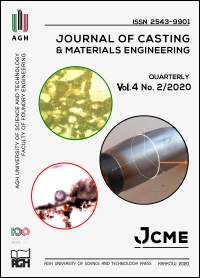Microstructural Analysis of Concrete Using Cow Bone Ash for Alkali-Silica Reaction (ASR) Suppression
DOI:
https://doi.org/10.7494/jcme.2020.4.2.34Abstract
Concrete pavements are prone to microstructural changes and deterioration when exposed to Alkali-Silica Reaction (ASR). ASR results in strength reduction, cracking, spalling and other defects in the concrete if left unchecked. Supplementary Cementitious Materials (SCMs) such as Cow Bone Ash (CBA) however can be used to improve concrete performance, hence its use in this study. Concrete samples were prepared at replacement levels of 0%, 5%, 10%, 15%, 20% and 30% of cement with Cow Bone Ash. The concrete samples were then subjected to petrographic and Scanning Electron Microscopy (SEM) analysis. Petrographic examination shows that the minimal and least amount of ASR gels and micro cracking were observed at 15% CBA replacement of cement in the concrete samples. Scanning Electron Microscopy (SEM) analysis shows that changes in the elemental composition of the concrete samples is related to the effect of CBA which enhances adhesion in the concrete. SEM analysis show that, in general, the change in microstructure in the concrete was mainly due to the change in the arrangement of the C-H-S compounds. The microstructure analysis indicates that CBA in concrete influences the densification of the concrete at the transition zone, resulting in a much lower porosity. This results in the concrete having a tightly bound layer that repels ingress of water and thereby inhibiting cracks and gel formation as water is a contributing factor to the ASR in concrete.
Downloads
References
Jozwiak-Niedzwiedzka D., Dąbrowski M., Gibas K., Antolik A.
& Glinicki M. (2018). Alkali-Silica Reaction and microstructure of concrete subjected to combined chemical and physical exposure conditions. MATEC Web of Conferences, 163(1–4), 1–10.
Sharma A.K. (2019). Cracks in Pavement Quality Concrete (PQC) – Causes and Remedies. International Advanced Research Journal in Science, Engineering and Technology, 6(10), 40–48.
Zapała-Sławeta Justyna & Owsiak Z. (2018). The use of lithium compounds for inhibiting alkali-aggregate reaction effects in pavement structures. IOP Conference Series: Materials Science and Engineering, 356, 1–10.
Lawrence E.D. (2015). Flawed concrete found on Detroit Metro Airport runway. Detroit Free Press. Retrieved from: http://
www.freep.com/story/news/local/michigan/wayne/2015/
/04/airport-needs-rebuild-million-runway/21236323/ [accessed: 14.10.2019].
Holt E. & Ferreira M. (2013). Addressing ASR in concrete construction in Finland. In: Nord. Mini Seminar. Alkali Aggregate Reaction in Concrete, Riga, Latvia, 1–15.
Tcherner J. & Aziz T.S. (2009). Effects of AAR on seismic assessment of nuclear power plants for life extensions. 20th International Conference on Structural Mechanics in Reactor Technology (SMiRT 20), Espoo, Finland, 9–14 August, 2009, (7-1789).
Doran D., Douglas J. & Pratley R. (2009). Refurbishment and repair in construction. Whittles Publishing, Scotland, UK.
Falade F., Ikponmwosa E. & Fapohunda C. (2012). Potential of pulverized bone as a pozzolanic material. International Journal of Scientific & Engineering Research, 3(7), 1–6.
Adanikin A., Falade F.A. & Olutaiwo A.O. (2019). Efficiency of Cow Bone Ash (CBA) in mitigating alkali silica reaction (ASR) based on accelerated mortar bar test (AMBT) in concrete pavements. UNILAG Faculty of Engineering International Conference on Managing the Environment (FEIC 2019). 15–18 October, 2019, University of Lagos, Nigeria.
Hassan M.S. (2014). SEM-Backscattered imaging analysis of cementitious composite matrix incorporating mineral admixture. Engineering and Technology Journal, 32(2), 696–703. Doi: 10.1590/s1517-707620170002.0145.
Magudeswaran P. & Saran A.S. (2017). SEM analysis on sustainable high performance concrete. International Journal of Innovative Research in Science, Engineering and Technology, 6(6),
–10246. Doi: 10.15680/IJIRSET.2017.0606016.
Balakrishnaiah D., Balaji K.V.G.D. & Srinivasa R.P. (2017). Application of SEM method to investigate the cause of effect of elevated temperatures on compressive strength for ternary blended concrete using metakaolin and micro silica. ARPN Journal of Engineering and Applied Sciences, 12(7), 2029–2036.
Kumar S.V., Rajkumar R. & Umamaheswari N. (2019). Study on mechanical and microstructure properties of concrete prepared using metakaolin, silica fume and manufactured sand. Rasayan Journal of Chemistry, 12(3), 1383–1389. Doi: 10.31788/RJC.2019.1235164
Uzbas B. & Aydin A.C. (2019). Analysis of fly ash concrete with Scanning Electron Microscopy and X-ray diffraction. Advances in Science and Technology Research Journal, 13(1), 100–110. Doi: 10.12913/22998624/114178.
BS 1881-211 (2016). Testing concrete. Procedure and terminology for the petrographic examination of hardened concrete (British Standard).
ASTM C1723 (2016). Standard guide for examination of hardened concrete using Scanning Electron Microscopy. Retrieved
from: https://www.astm.org/Standards/C1723.htm [accessed:
07.2019].
Chen P.-W., Fu X. & Chung D.D.L. (1997). Microstructural and mechanical effects of latex, methylcellulose and silica fume on carbon fiber reinforced cement. ACI Materials Journal, 94(2), 147–155.
Liu D.J., Chen M.J., Xue L. & He F. (2018). The effect of carbon fiber on concrete compressive strength. Advanced Materials Research, 1145, 106–111.
Kotaro D., Sachiko H., Hideki K. & Eiji A. (2018). Effects of oxygen pressure and chloride ion concentration on corrosion of Iron in mortar exposed to pressurized humid oxygen gas. Journal of Electrochemical Society, 165(9), 582–589.
Qureshi M. & Barbhuiya S. (2016). Effects of silica fume on the strength and durability properties of concrete. 1st International Conference on Civil Engineering for Sustainable Development – Opportunities and Challenges (CESDOC 2016), 19–21 December, 2016, Guwahati, Assam, India, 117–120.
Downloads
Published
Issue
Section
How to Cite
Accepted 2020-07-01
Published 2020-07-15


